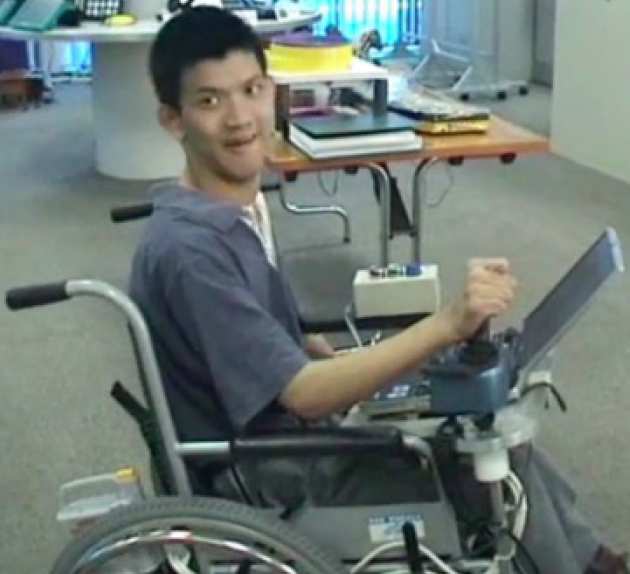Collaborative wheelchair assistant and brain controlled wheelchair
 Many individuals have motor disability preventing them from using a wheelchair using conventional access methods. We have developed a Collaborative Wheelchair Assistant (CWA) to help these persons gaining motion independence.
Many individuals have motor disability preventing them from using a wheelchair using conventional access methods. We have developed a Collaborative Wheelchair Assistant (CWA) to help these persons gaining motion independence.
Our approach consists in simplifying maneuvering by providing virtual paths along which the wheelchair is guided. The user is in charge of motion via speed control, can for example stop the wheelchair to discuss with a friend or avoid a danger such as a fire or obstacles, which may not be detected by artificial sensors. Path guidance enables efficient movement despite limited motion control such as poor coordination, pathological tremor or limited memory. By relying on the planning ability of the user, complex sensor processing and decisions system are not needed, making the system simple and low-cost.
We have developed a prototype with efficient tools to trace guiding paths and adapt these paths to changes in the environment or wishes of the user. Experiments with able-bodied subjects have shown that our system enables them to minimize control effort without compromising time or flexibility to modifications of the environment. Tests performed in collaboration with the Society for the Physically Disabled in Singapore showed that cerebral palsy and traumatic brain injury individuals, who could initially not use a power wheelchair, could train safely with our system, and learned to use it efficiently, in a few sessions.
We have also developed the first brain controlled wheelchair able to move in a building environment.
Related publications
- ES Boy, CL Teo, E Burdet (2002), Collaborative Wheelchair Assistant.Proc IEEE/RJS International Conference on Robotics and Intelligent Systems (IROS) 2: 1511-6.
- B Rebsamen, E Burdet, C Guan, H Zhang, CL Teo, Q Zeng, M Ang and C Laugier (2006), A Brain-Controlled Wheelchair Based on P300 and Path Guidance. Proc IEEE / RAS-EMBS Int. Conf on Biomedical Robotics and Biomechatronics (BioRob) 1101-6.
- B Rebsamen, E Burdet, C Guan, CL Teo, Q Zeng, C Laugier and M Ang (2007), Navigating ones Wheelchair in a Building by Thought, IEEE Intelligent Systems 22: 18-24 (feature article).
- Q Zeng, E Burdet, B Rebsamen and CL Teo (2008), A Collaborative wheelchair system. IEEE Transactions on Neural Systems and Rehabilitation Engineering 16(2): 161-70.
- Q Zeng, E Burdet, B Rebsamen and CL Teo (2008), Collaborative path planning for a robotic wheelchair, Disability and Rehabilitation: Assistive Technology 3(6): 315-24.
- Q Zeng, E Burdet and CL Teo (2009), Evaluation of a collaborative wheelchair system in cerebral palsy and traumatic brain injury users, Neurorehabilitation and Neural Repair 23(5): 494-504.
- B Rebsamen, C Guan, H Zhang, C Wang, CL Teo, M Ang and E Burdet (2010), A brain controlled wheelchair to navigate in familiar environments. IEEE Trans. on Neural Systems and Rehabilitation Engineering (TNSRE), Vol. 18, No. 6, 2010.


